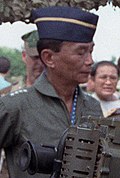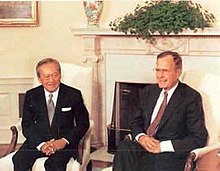1991 Thai coup d'état
| 1991 Thai coup d'etat | |||||||
|---|---|---|---|---|---|---|---|
 Sunthorn Kongsompong coup leaders | |||||||
| |||||||
| Belligerents | |||||||
|
|
| ||||||
| Commanders and leaders | |||||||
|
|
| ||||||
| Strength | |||||||
| Thai military +283,000[1] | None | ||||||
| Casualties and losses | |||||||
| None | None | ||||||
The 1991 Thai coup d'état was a military coup against the democratic Chatichai Choonhavan government, carried out by Thai military leaders on 23 February. Although the figure head was Sunthorn Kongsompong, there was a military influence from military leaders, Chavalit Yongchaiyudh, Suchinda Kraprayoon, and Kaset Rojananil in the conflict. Chalerm Yubamrung, a politician, was also involved in the beginning of the conflict which began since 1990 but reached the peak in February 1991 due to a strong executive order of Chatichai. Later in May 1992, protesters calling for democracy were massacred by the military regime, known as 'Black May.'
Background
Prelude

In 1990, Under Chatichai premiership, Chavalit was appointed as Defence Minister and Deputy Prime Minister. Group of top military personnel within the government side such as, Suchinda Kraprayoon and Kaset Rojananil, classmates in the Armed Forces Academies Preparatory School Class 5, had a good relationship with Chatichai. Nevertheless, Chavalit and the military had an ongoing conflict with Chalerm Yubamrung, Minister for Office of the Prime Minister, overseeing the Mass Communications Organization of Thailand. Chavalit then resigned from his position on 11 June.[3]
On 17 June 1990, Chalerm ordered the trailer-mounted
Later in August, Arthit Kamlang-ek, the leader of the opposition party, joined the government side. That built up more conflict in the parliament. Military leaders pressured Chatichai to dismiss Chalerm, and Chatichai followed it on 8 November but kept Chalerm as Deputy Education Minister. The military decided to announce no support to the Premier, based on the rumor circulating that Chatichai planned to dismiss Suchinda and Sunthorn.[4]
The tension between the military and Chatichai reached its peak in February 1991, when Chatichai dismissed
Coup
Chatichai Choonhavan and Arthit Kamlang-ek were arrested by Royal Thai Air Force men in an airforce base in Chiang Mai before taking off to Bangkok on 23 February 1991, ended the longest prime minister tenure ever served as democratic leader elected in Southeast Asia at that time. In Bangkok, hundreds of full-gear armed soldiers and armored cars took over the Government House. The radio and television stations were captured, announcing the statements urging people to remain peaceful.[6]
The alleged reasons for coup against the democratic government were
Three days later, on 26 February, King Bhumibol Adulyadej approved the coup, and never before in the history, the king criticised Chatichai government that 'failed to gain the people's confidence' and "failed to maintain peace and order in the country.' Bhumibol also urged people 'to remain calm' and called the military 'to follow the orders' of Sunthorn.[9]
Sunthorn formally accepted the king's appointment at the Thai Army Auditorium, to celebrate the royal approval, the junta leaders toasted each other with champagne in a televised ceremony. The SET index value revived to the same value as pre-coup, after it went down by 7%.[9]
Conflict between Armed Forces Academies Preparatory School Class 5 and Class 7 was one of the root causes according to Tamada.[10]
Aftermath
The United States immediately suspended $16 million aid for development projects in military and economic.[6]
1991 constitutions
The
Disappearance of Tanong Po-arn
Tanong was scheduled to appear at the
Black May
The 1991 constitution allowed Suchinda Kraprayoon to be appointed as prime minister. That caused 17–20 May 1992 popular protest in Bangkok against the government of Suchinda and the military crackdown that followed. Up to 200,000 people demonstrated in central Bangkok at the height of the protests. The military crackdown resulted in 52 government-confirmed deaths, hundreds of injuries including journalists, over 3,500 arrests, hundreds of disappearances, and eyewitness reports of a truck filled with bodies leaving the city.[16] Many of those arrested are alleged to have been tortured.
See also
- Black May (1992)
- 1985 Thai coup d'état attempt
- Manoonkrit Roopkachorn
References
Citations
- ^ "Thailand Military Size 1985-2021". www.macrotrends.net.
- ^ Tamada 1995, p. 331.
- ^ a b Tamada 1995, p. 332.
- ^ Tamada 1995, p. 333.
- ^ Tamada 1995, p. 334.
- ^ a b c d Magistad 1991a.
- ^ a b RG 1991.
- ^ Tamada 1995, pp. 334–335.
- ^ a b Magistad 1991b.
- ^ Tamada 1995, p. 336.
- ^ Paul Chambers, Good governance, political stability, and constitutionalism in Thailand 2002: The state of democratic consolidation five years after the implementation of the 1997 constitution[permanent dead link], King Prajadhipok's Institute, 10 August 2002
- ISBN 0-300-10682-3
- ^ Bangkok Post, "King calls for compromise on charter", 5 December 1991
- ^ a b Amnesty International, Thailand: The "disappearance" of labour leader Tanong Pho-arn, 19 June 1991 Archived 1 September 2006 at the Wayback Machine, AI Index: ASA 39/007/2001, released 18 June 2001
- ISBN 0-415-31862-9.
- ISBN 1-879707-10-1. Retrieved 2018-10-07.
Sources
- "แถลงการณ์คณะรักษาความสงบเรียบร้อยแห่งชาติ: คำชี้แจงเหตุผลยึดอำนาจ" [Announcement of the Reasons of the Coup]. Royal Gazette No. 108 of 23 February 1991 (PDF) (in Thai). Royal Thai Government Gazette. Archived from the original(PDF) on March 4, 2016.
- Magistad, Mary Kay (24 February 1991a). "Thailand's Civilian Premier Overthrown In Military Coup". Washington Post.
- Magistad, Mary Kay (27 February 1991b). "Thai King Approves Army's Coup". Washington Post.
- Tamada, Yoshifumi (1995). "Coups in Thailand, 1980-1991:". Japanese Journal of Southeast Asian Studies. 33 (3). Kyoto: .
